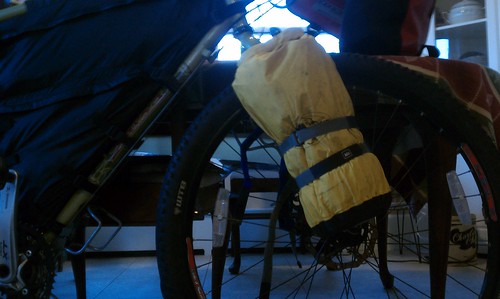Love the Jannd top tube bag as crud catcher idea. I love my jandd top tube bag. Will have to try it, but i worry there will be no side to side support and that it won't be big enough to pack with my heaviest gear. Might make a good spot for first aid kit, two spare tubes and tool kit. Those I usually keep in the bottom of my main triangle frame bag.
However... there's a new game in town for down tube use!
 Salsa anything cages have arrived!
Salsa anything cages have arrived! by
mmeiser2, on Flickr
The thing could probably hold a whole gallon of water if you could find a nice round gallon container as opposed to square. That said I think a 1-liter bottle is perfect.
Unbelieveable storage. (And the fargo unbelieveable ground clearance and bbracket / crank clearance.)
What's funny is this cage has virtually no chance of smacked on a log, the plastic container on there is a Cranberry juice container (only thing I had with me that day) so it's hanging down several inches lower then a 2-liter might.
This is typically where I'd store excess water in three seasons of the year. Most of the time it'd be empty except when crossing remote regions or in the evening when I'd fill it up toward the end of the day to dry camp.
However... in the winter it's a whole new ballgame. Anything placed that exposed would freeze really darn quick.
== winter water tricks ==
Most people will simply use water bladders on their back under the outer windbreaker if extremely cold.
Personally i hate stuff on my back though I will use a pack for a couple of liters of extra water in remote areas or in the evenings for dry camping.
The only other alternative for winter touring is Nalgenes. Nothing else I've found works save a stainless steal vacuum thermos and that's to heavy and carries to little for agressive biking. Indeed stainless steel kanteens can boil water... but are useless for storing water in the winter. Standard biking wb's just suck for winter. Useless. Even polartec are of no match to freezing temps.
I love lightweight plastic, i.e. the two liter pop bottle or 1 liter smart water bottles in summer. Extremely light, good volume, easily replaced. However in the winter if these freeze there's no way to unfreeze them save sitting inside someplace civilized for hours. They just melt when put in contact with flame or boiling water. Mine as well throw them out if they get frozen. Less then useless, dead weight. Better to be carrying no water at all then frozen water.
On the other hand a nalgene can have boiling water poored in them and can be unfrozen fairly quickly even if frozen solid... oh, and they don't split or crack when frozen solid.
== insulating a nalgene ==
If one were pannier touring one would just stick their nalgene in one of their panniers surrounded by sleeping bag. Superb protection.
However... noone on this group by nature uses panniers. Indeed the bivy roll is the only place one might use the sleeping bag trick and then the wb is to inaccessible.
The best improvised trick is a sock or two (preferably heavy wool) and a plasitc bag or dry bag. Since most people carry a spare pair of smartwook this makes a superb trick. Ultralight. Efficiency is good enough for most instances as long as it's not below 20 and you're not carrying the water for to many hours.
Oh... some may use production made nalgene cozy's... awesome, but why when they're so easy to make and make better.
Personally though the ultimate trick is to roll up your insulating sleeping mat into a sleave.
I used this technique with a 48oz water bottle a Big Agnes Aircore and dropped it in a dry bag and mounted it on my front fork with a Salsa Anytghing / Everything cage.
 Water
Water by
mmeiser2, on Flickr
Of course you need a sock or other lofting article in the bottom or top to keep the ends insulated.
Under my tests the Wool sock trick lasted some seven hours keeping room temp water from freezing in my freezer. However the Nalgene in insulated sleeping pad trick lasted 27 hours! Wow. With wind rushing around it on the trail and road this should be more then enough to go through a whole day without worrying about freezing.
BTW... the nalagene remains uber accessible rolled in the sleeping mat. Easily slid out and slid back into the roll.
Oh, and of course always use hot water. What happens is your airmat will be freezing cold, whatever the ambient temp is. The warm water will immediately be cooled a bit but in so doing raise the warmth of the insulation. It's the same as doing a little jig in your old sleeping bag to warm it when you first get in. Only your water can't jig to produce heat.

Man... I seem to have gotten somewhat off point, but then water is the heaviest thing most people carry.